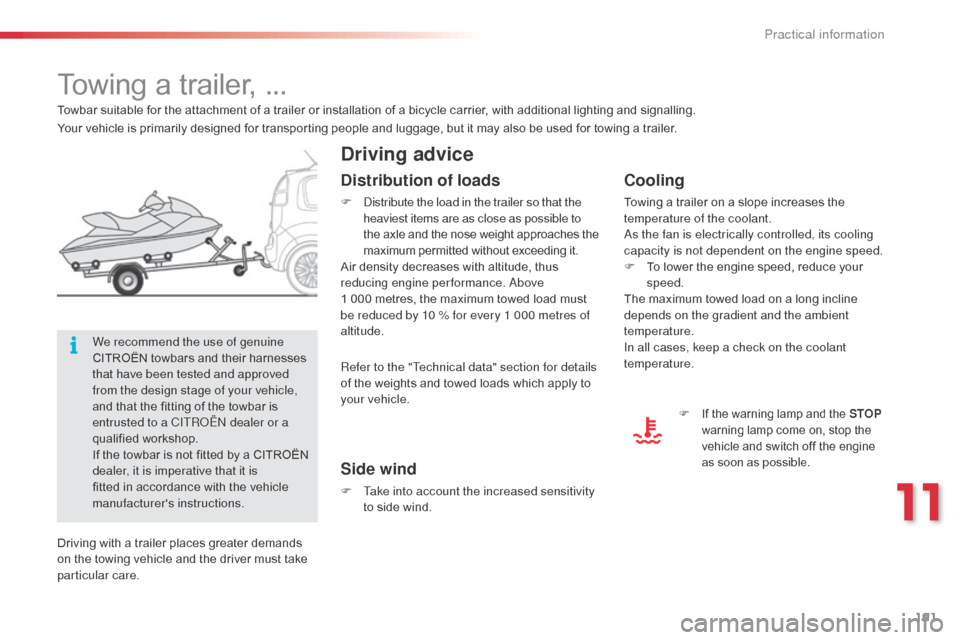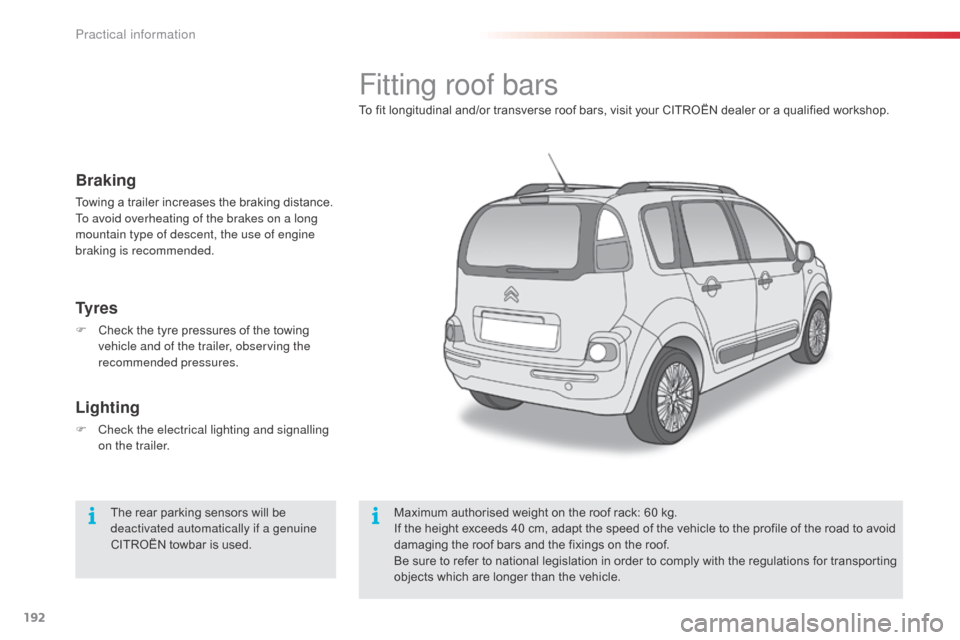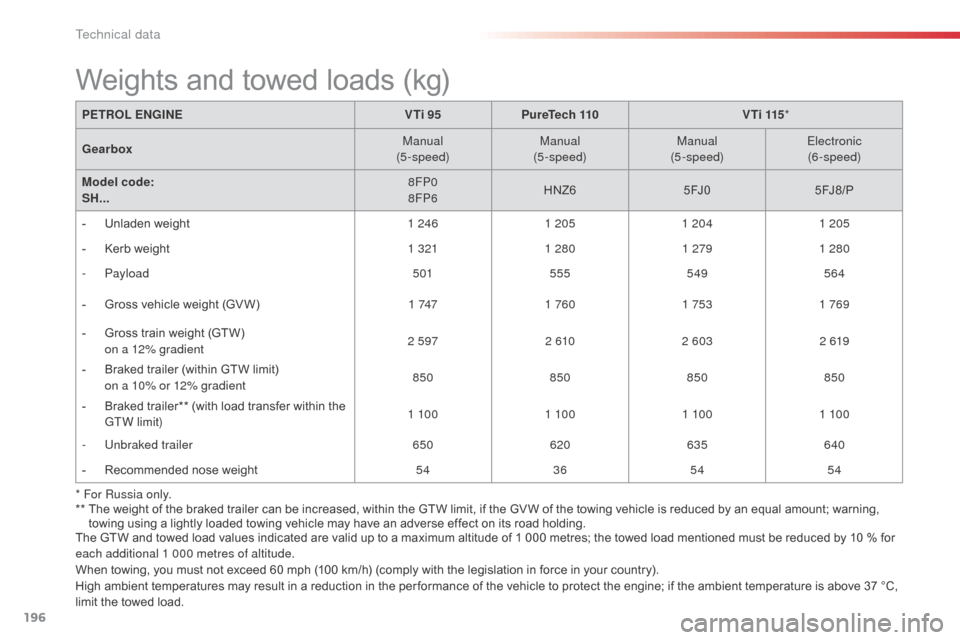Max tow Citroen C3 PICASSO 2016 1.G Owner's Manual
[x] Cancel search | Manufacturer: CITROEN, Model Year: 2016, Model line: C3 PICASSO, Model: Citroen C3 PICASSO 2016 1.GPages: 292, PDF Size: 8.23 MB
Page 46 of 292

44
C3Picasso_en_Chap03_confort_ed01-2015
In order for these systems to be fully effective, follow the guidelines on operation and
maintenance below:
F
I
f the interior temperature remains very high after the vehicle has been parked in the
sun for a considerable time, first ventilate the passenger compartment for a
few minutes.
P
lace the air flow control at a sufficient level to provide an adequate renewal of air in
the passenger compartment.
F
T
o obtain an even air distribution, take care not to obstruct the exterior air intake grilles
located at the base of the windscreen, the nozzles, the vents and the air outlets, as well
as the air extractor located in the passenger compartment on both sides of the rear shelf.
F
D
o not cover the sunshine sensor, located on the dashboard (behind the instrument
panel); this is used for regulation of the air conditioning system.
F
O
perate the air conditioning system for 5 to 10 minutes, once or twice a month to keep it
in good working order.
F
E
nsure that the passenger compartment filter is in good condition and have the filter
elements replaced regularly (see the "Checks" section).
W
e recommend the use of a combined passenger compartment filter. Thanks to its
second special active filter, it contributes to the purification of the air breathed by the
occupants and the cleanliness of the passenger compartment (reduction of allergic
symptoms, bad odours and greasy deposits).
F
T
o ensure correct operation of the air conditioning system, you are also advised to have
it checked regularly.
F
I
f the system does not produce cold air, do not use it and contact a CITROËN dealer or
a qualified workshop. The air conditioning system does not
contain chlorine and does not present
any danger to the ozone layer.
When towing the maximum load on a steep gradient in high temperatures, switching off the
air conditioning saves engine power and so improves towing capacity.
Recommendations for ventilation and air conditioning
The condensation created by the air
conditioning results in a discharge
of water under the vehicle which is
perfectly normal.
Comfort
Page 193 of 292

191
C3Picasso_en_Chap11_informations-pratiques_ed01-2015
Towing a trailer, ...
Driving advice
Cooling
Towing a trailer on a slope increases the
temperature of the coolant.
As the fan is electrically controlled, its cooling
capacity is not dependent on the engine speed.
F
T
o lower the engine speed, reduce your
speed.
The maximum towed load on a long incline
depends on the gradient and the ambient
temperature.
In all cases, keep a check on the coolant
temperature.
Side wind
F Take into account the increased sensitivity to side wind.
F If the warning lamp and the STOP
warning lamp come on, stop the
vehicle and switch off the engine
as soon as possible.
Towbar suitable for the attachment of a trailer or installation of a bicycle carrier, with additional lighting and signalling.
Distribution of loads
F Distribute the load in the trailer so that the heaviest items are as close as possible to
the axle and the nose weight approaches the
maximum permitted without exceeding it.
Air density decreases with altitude, thus
reducing engine performance. Above
1
000 metres, the maximum towed load must
be reduced by 10
% for every 1 000 metres of
altitude.
We recommend the use of genuine
CITROËN towbars and their harnesses
that have been tested and approved
from the design stage of your vehicle,
and that the fitting of the towbar is
entrusted to a CITROËN dealer or a
qualified workshop.
If the towbar is not fitted by a CITROËN
dealer, it is imperative that it is
fitted in accordance with the vehicle
manufacturer's instructions.
Driving with a trailer places greater demands
on the towing vehicle and the driver must take
particular care. Your vehicle is primarily designed for transporting people and luggage, but it may also be used for towing a trailer.
Refer to the "Technical data" section for details
of the weights and towed loads which apply to
your vehicle.
11
Practical information
Page 194 of 292

192
C3Picasso_en_Chap11_informations-pratiques_ed01-2015
Fitting roof bars
To fit longitudinal and/or transverse roof bars, visit your CITROËN dealer or a qualified workshop.Maximum authorised weight on the roof rack: 60 kg.
If the height exceeds 40 cm, adapt the speed of the vehicle to the profile of the road to avoid
damaging the roof bars and the fixings on the roof.
Be sure to refer to national legislation in order to comply with the regulations for transporting
objects which are longer than the vehicle.
Braking
Towing a trailer increases the braking distance.
To avoid overheating of the brakes on a long
mountain type of descent, the use of engine
braking is recommended.
Ty r e s
F Check the tyre pressures of the towing vehicle and of the trailer, observing the
recommended pressures.
Lighting
F Check the electrical lighting and signalling on the trailer.
The rear parking sensors will be
deactivated automatically if a genuine
CITROËN towbar is used.
Practical information
Page 198 of 292

196
C3Picasso_en_Chap12_caracteristiques-techniques_ed01-2015
The GTW and towed load values indicated are valid up to a maximum altitude of 1 000 metres; the towed load mentioned must be reduced by 10 % for
each additional 1 000 metres of altitude.
When towing, you must not exceed 60 mph (100 km/h) (comply with the legislation in force in your country).
High ambient temperatures may result in a reduction in the per formance of the vehicle to protect the engine; if the ambient temperature is above 37 °C,
limit the towed load. * For Russia only.
**
T
he weight of the braked trailer can be increased, within the GTW limit, if the GV W of the towing vehicle is reduced by an equal amount; warning,
towing using a lightly loaded towing vehicle may have an adverse effect on its road holding.
PETROL ENGINE
VTi 95PureTech 110 V T i 115*
Gearbox Manual
(5-speed) Manual
(5-speed) Manual
(5-speed) Electronic
(6-speed)
Model code:
SH... 8FP0
8FP6
HNZ6
5 FJ 05 FJ 8 / P
-
U
nladen weight
1 2461 205 1 204 1 205
-
K
erb weight
1 3211 280 1 2791 280
-
Payload
501555 549564
-
G
ross vehicle weight (GV W)
1 7471 760 1 7531 769
-
G
ross train weight (GTW)
o
n a 12% gradient
2 597
2 6102 603 2 619
-
B
raked trailer (within GTW limit)
o
n a 10% or 12% gradient
850
850850850
-
B
raked trailer** (with load transfer within the
GTW limit) 1 10 0
1 10 01 10 01 10 0
-
U
nbraked trailer
650620635 640
-
R
ecommended nose weight
543654 54
Weights and towed loads (kg)
Technical data
Page 200 of 292

198
C3Picasso_en_Chap12_caracteristiques-techniques_ed01-2015
* The weight of the braked trailer can be increased, within the GTW limit, if the GV W of the towing vehicle is reduced by an equal amount; warning, towing using a lightly loaded towing vehicle may have an adverse effect on its road holding.
DIESEL ENGINE
BlueHDi 100
Gearbox Manual (5-speed)
Model code:
SH... BHY6
-
U
nladen weight
1 240
-
K
erb weight
1 315
-
Payload
560
-
G
ross vehicle weight (GV W)
1 800
-
G
ross train weight (GTW)
o
n a 12% gradient
2 700
-
B
raked trailer (within GTW limit)
o
n a 10% or 12% gradient
900
-
B
raked trailer* (with load transfer with the
GTW limit) 900
-
U
nbraked trailer
650
-
R
ecommended nose weight
36
The GTW and towed load values indicated are valid up to a maximum altitude of 1 000 metres; the towed load mentioned must be reduced by 10 % for
each additional 1 000 metres of altitude.
When towing you must not exceed 60 mph (100 km/h) (comply with the legislation in force in your country).
High ambient temperatures may result in a reduction in the per formance of the vehicle to protect the engine; if the ambient temperature is above 37 °C,
limit the towed load.
Weights and towed loads (kg)
Technical data